Asian Pork Recipes for Chinese New Year
Posted by Julie on Feb 4th 2019
There’s no time like the present to learn more about Chinese New Year, because today is New Year’s Eve. While there are many traditions and superstitions surrounding Chinese New Year, we’re going to offer some suggestions for what to eat. The Year of the Pig begins tomorrow, so we’re highlighting Asian pork recipes. Keep reading to learn what different foods symbolize, including pork, and how to cook them.
Lucky Foods for Chinese New Year
It’s the Year of the Pig, and pork is a lucky food. While many foods symbolize wealth, including pork, it also represents strength. We’ll gladly take both. Dumplings also represent wealth, based on a nearly 2,000-year tradition. Spring rolls are another harbinger of good fortune because of their golden color, and the fresh vegetables inside represent a fresh start. Finally, noodles symbolize a long life: Longer noodles foretell many years of life. Naturally, it’s important not to break them or bite through them; simply slurp them down.
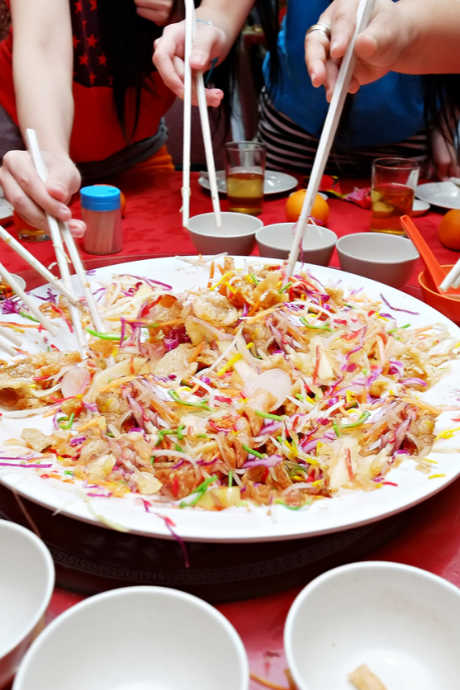
We've gathered four recipes that incorporate pork with other traditional lucky foods for Chinese New Year. Consider building a celebratory dinner around them to kick off the new year. We hope they bring you strength, wealth, and longevity.
Asian Pork Recipes: Roast Pork Tenderloin
If you’re more familiar with ordering Chinese food than making it yourself, start easy with this roast pork tenderloin recipe from Mel’s Kitchen Cafe. Take two pork tenderloins and marinate them in a combo of soy sauce, brown sugar, ginger, sesame oil, garlic, and red pepper. All of these are basic Asian flavors, and we bet you have most of them on hand. Do use fresh ginger, and adjust the amount of red pepper based on your tolerance for heat.
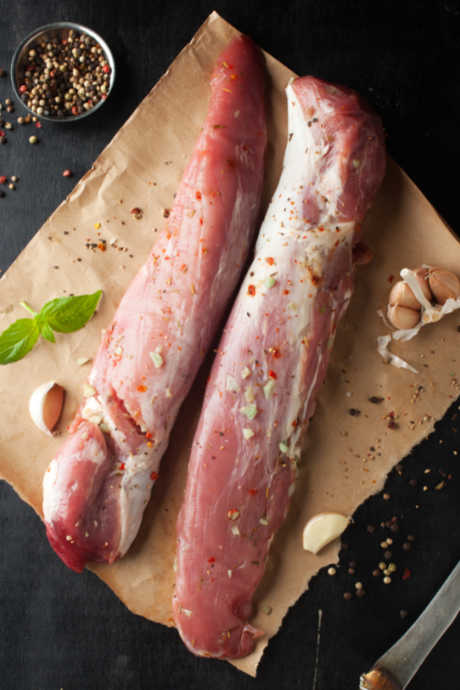
Marinate the pork for as little as 30 minutes or up to three hours. Then roast it on a foil-covered pan for about 40 minutes, or until your cooking thermometer reads 150-155°F. While you’re roasting the pork, get the glaze ingredients ready to go on the stovetop. While the pork is resting, boil the glaze. Then slice the pork and pour the glaze over it just before serving. Mel shows this pork served with rice pilaf, but if you want to honor Chinese tradition, serve with noodles instead. Remember, the longer the better.
Asian Pork Recipes: Hoisin Pork With Rice Noodles
Ready for a slightly more involved Asian pork recipe? Try this Hoisin Pork from Pinch of Yum. The sauce, which you’ll also use to marinate the pork, includes hoisin sauce and fish sauce in addition to the usual soy sauce, garlic, ginger, and sesame oil. Hoisin sauce is made from fermented soybean paste, and it’s sometimes called Chinese barbecue sauce. It’s thicker and sweeter than soy sauce, though not as sweet as plum sauce. Fish sauce is more simple: It’s fermented fish, with a salty, savory flavor. Both of these ingredients amp up the umami in this recipe and other Asian dishes. Go easy with fish sauce, but you can use a heavier hand with hoisin sauce.
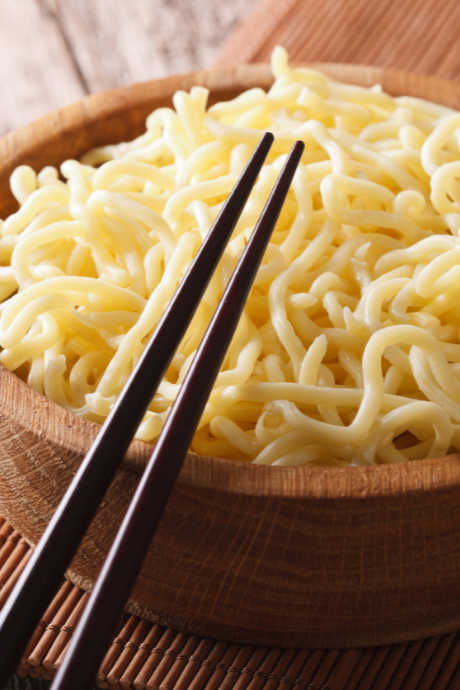
We would probably scale back on the amount of pork called for in this recipe, but make the full amount of sauce. Use two-thirds of it to marinate the pork as directed, then use the rest when you top the noodles with pork and other add-ins. Lindsay suggests carrots, scallions, peanuts, and cilantro, which all sound delicious to us.
Asian Pork Recipes: Pork Spring Rolls
This recipe for pork spring rolls from Serious Eats serves as a great example for using meat to add flavor and texture, without making it the main event. Contrast six ounces of pork shoulder (one of the most economical cuts of pork) with four heaping cups of vegetables. If you want even more vegetables in your spring rolls, shred or julienne some carrots too. Granted, you’ll encase all of these veggies in spring roll wrappers and fry them in oil. We never said this dish was healthful.
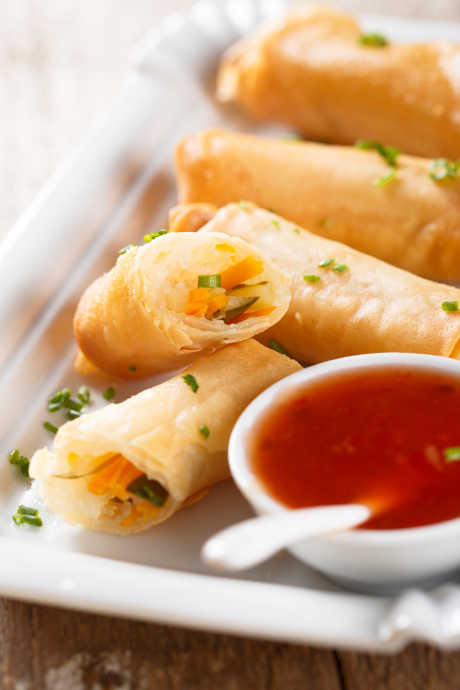
You’ll definitely want a wok for this recipe, as opposed to a skillet. The deep sloping sides will make it easier to stir fry all of the ingredients, from wilting and softening the cabbage and sprouts to cooking the pork and mushrooms. You’ll also want a sharp knife with an ergonomic handle to make quick, comfortable work of slicing the pork into slender strips.
Much of what we covered in our post on wonton wrappers applies to spring roll wrappers too; they’re just somewhat larger. Serious Eats also offers a step-by-step tutorial on wrapping spring rolls. Use a little moisture to stick the wrappers in place, and they won’t fall apart when you fry them.
Asian Pork Recipes: Pork Dumplings
We’re so excited to try this family recipe from Maggie of Omnivore’s Cookbook. These dumplings are what Maggie grew up eating in Beijing, and from the story she tells, the addition of shrimp makes them special even among Chinese families who eat dumplings every day.
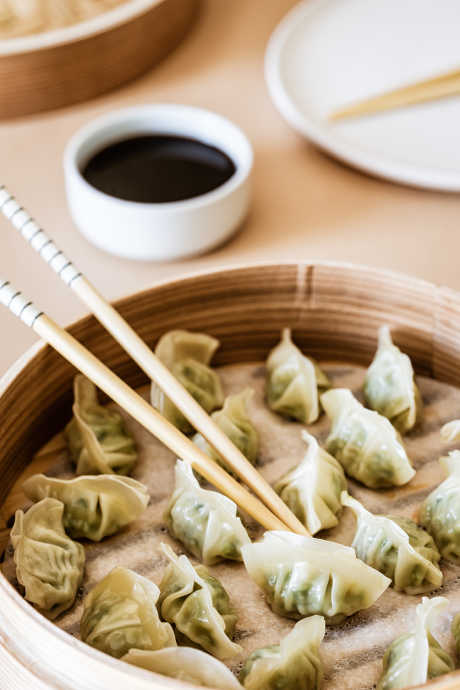
After your first reading of the recipe, you may be a little intimidated by the thought of homemade dumpling dough and a bamboo steamer. First, don’t worry about making dumpling dough. It’s perfectly fine to use store-bought dumpling wrappers. Second, read this reassuring piece on Bon Appetit about all the ways you can use bamboo steamers. They’re inexpensive, versatile, and will make your dumplings look authentic whether you make the dough from scratch or not.
We mentioned how a wok is essential for the spring rolls, and you’ll want one for this recipe too. Not because you’re going to stir fry the dumplings, but because a wok is an ideal vessel for holding bamboo steamer baskets. That’s because, similar to a double boiler, you don’t want the simmering water to come into contact with the basket. You’re steaming the dumplings, not boiling them.
This recipe makes 40-50 dumplings. If you don’t think you can finish them all, invite us to your party. You can also freeze the assembled dumplings on a baking sheet, and then transfer them to a freezer bag. We actually love this idea. Make a double batch of dumplings so you’ll have them handy for those evenings when you’re tempted by Chinese takeout.
 Free shipping over $49
Free shipping over $49










